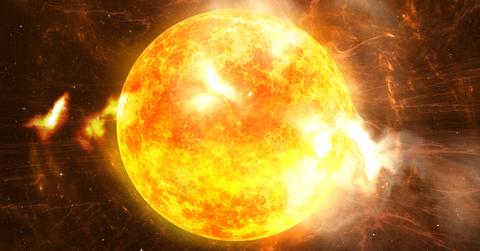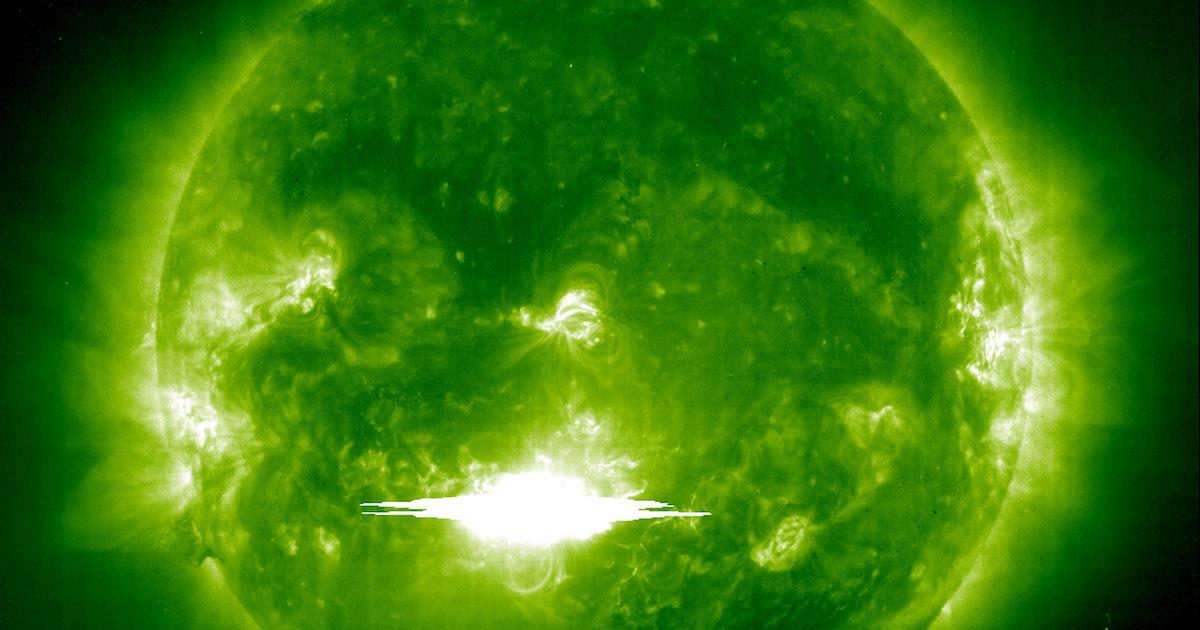A Look at the Formidable Solar Flares of 2023
Updated July 5 2023, 4:16 p.m. ET

If you're a fan of watching celestial events, you may feel indifferent to solar flares, since they are not visible to the naked eye (well, unless you want to burn your eyeballs, that is...).
But still, there is so much to learn about solar flares. Not only are solar flares anticipated to become more powerful, but there have been a a few significant X-class solar flares and solar storms in 2023 that have had some pretty interesting affects on Earth.
In fact, an April 2023 solar storm actually made the northern lights visible in places where seeing them is typically impossible, and a July 2023 solar flare actually caused brief radio blackouts in parts of the U.S.
Keep reading to learn more about the solar flares of 2023 thus far, as well as what you need to know about how solar flares can impact us on Earth.

The third most-powerful solar flare ever observed in X-ray wavelengths erupted from Sunspot 486 early Oct. 28, 2003.
What are solar flares and solar storms?
As we've previously reported on Green Matters, solar flares are intense radiation bursts that come from sunspots, which are spots on the sun with incredibly high magnetic fields.
According to NASA, solar flares simply appear as bright spots on the sun. Sometimes they just last for a few minutes, but they can also last up to several hours at a time.
NASA also describes solar flares are the most powerful explosive events to occur in the entire solar system — the agency notes that just one large solar flare produces energy equivalent to what we'd need to power planet Earth for about 20,000 years.
And solar flares (as well as coronal mass ejections) can result in solar storms, a term that essentially refers to the effects that we on Earth feel from solar flares happening on the sun, as per Wonderopolis — more on that later.
How often do solar flares occur?
Smaller solar flares occur fairly frequently, and these are nothing to worry about. But X-class solar flares, which are the most powerful solar flares, happen much less frequently. X-class solar flares are categorized on a scale in which a number is placed after the X to denote its severity, such as X1 or X10.
In case you were wondering, the most powerful solar flare on record happened in 2003. It measured X28 — though it would have probably measured higher if only it hadn't crashed the measurement sensors!

A solar flare on the surface of the sun, caused by the sudden release of energy from the magnetic field, taken from the Skylab space station in 1974.
Here's a look at the solar flares of 2023 thus far:
As of publication, there have been a handful of X-class solar flares in 2023, according to SpaceWeatherLive.com.
The first X-class solar flare of 2023 occurred on Jan. 5, peaking around 8 p.m. ET, as per NASA. This marked the first X-class solar flare in about two months, as reported by Scientific American.
NASA classified this one as an X1.2 flare, meaning it had a strength of 1.2 on the X-class solar flare scale.
As per SpaceWeatherLive.com, the second X-class solar flare of the year occurred on Jan. 9, and measured in at X1.9, and it was followed directly by one on Jan. 10, which measured X1. It's quite unusual for three X-class solar flares to occur within days of each other.
Then on Feb. 11, one measured X1.1; on Feb. 17, one measured X2.2; on March 3, one measured X2.2; and on March 29, one measured X1.2.
Then, on Sunday, July 2, 2023, at 7:14 p.m. ET, a large sunspot exploded, resulting in a striking solar flare, as reported by Space.com. The solar flare was so powerful, in fact, that the flare’s radiation ionized the Earth's atmosphere, and actually caused a radio blackout over areas in the Western U.S. and over the Pacific Ocean, as per SpaceWeather.com.
According to SciTechDaily, the solar flare was classified as an X1.0 flare. X-class denotes the most intense flares, while the number provides more information about its strength.
And in April, there was one particularly interesting solar storm.
An April 2023 solar storm made the northern lights more visible.
As the National Oceanic and Atmospheric Administration observed, on April 21, 2023, there was a solar flare that resulted in a "severe" geomagnetic storm hitting the Earth two days later.
The solar storm ejected plasma towards the Earth at the high speed of 2 million miles per hour, the NOAA noted.
According to AP News, the solar storm made the northern lights visible much farther south than normal. Many shared images of their astonishing views on social media, with clear views of the Aurora Borealis in places as far south as Texas, as well as in Ukraine, Arizona, Oklahoma, and more.
But solar flares aren't all cool — according to the NOAA, intense solar storms can cause spacecrafts in low Earth orbit to experience drag and issues with tracking, and therefore potentially harm astronauts. And as per Syfy, solar storms can also interfere with the electrical grid, navigation signals, and radio transmissions.
So while solar flares can lead to incredible things (like seeing the aurora borealis from places like Oklahoma), too many of them could lead to trouble — and they aren't going to cease anytime soon.
Solar flare 2023 predictions:
The most notable solar flare prediction for 2023 is that solar flares will occur more frequently and with more intensity throughout the year. The solar cycle is an 11-year cycle that affects the sun's magnetic fields and sunspots, and every 11 years, we hit a solar maximum.
According to Syfy, in April 2023, we are approaching solar maximum of solar cycle 25, with the peak coming in July 2025. So up until then, we can look bank on more solar flares than we've seen in the 2020s.
Syfy also asserts that in the near future, it is unlikely that we'll experience a solar flare "powerful enough to really mess things up," writing that "no one aside from a few incredibly dedicated scientists even noticed" the M-Class and X-Class solar flares that happened on April 22.
This article, originally published on April 27, 2023, has been updated.